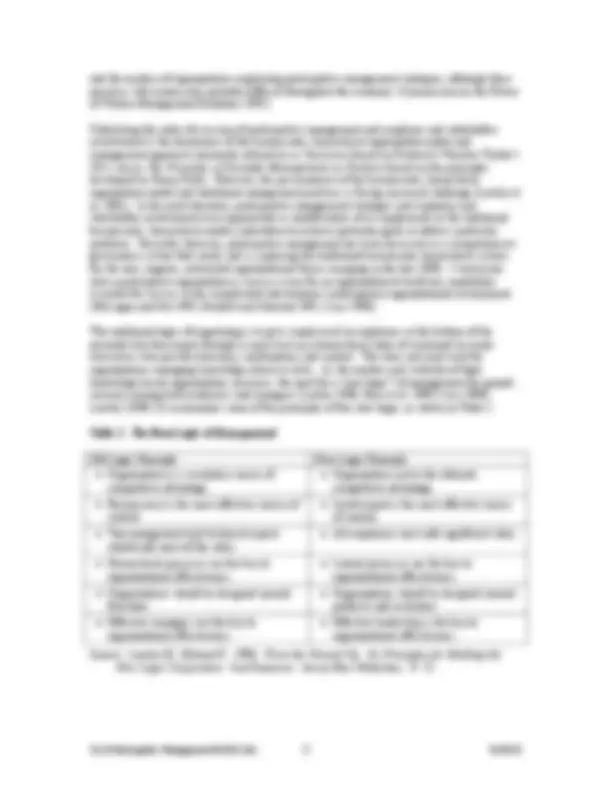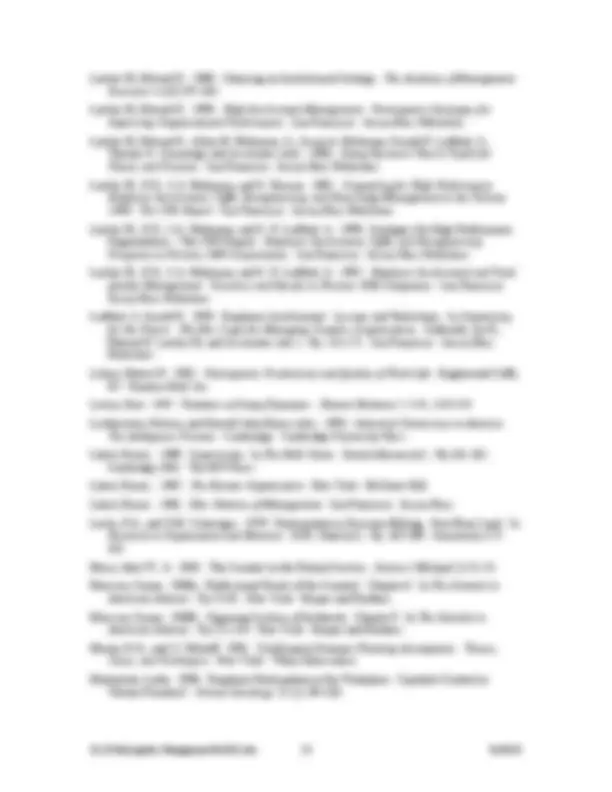





















Study with the several resources on Docsity

Earn points by helping other students or get them with a premium plan


Prepare for your exams
Study with the several resources on Docsity

Earn points to download
Earn points by helping other students or get them with a premium plan
Community
Ask the community for help and clear up your study doubts
Discover the best universities in your country according to Docsity users
Free resources
Download our free guides on studying techniques, anxiety management strategies, and thesis advice from Docsity tutors
Participative Management and Employee and Stakeholder Involvement Management Benchmark Study-Book Summary Chapter 10-Literature-Elizabeth L. Malone Participative Management and Employee and Stakeholder Involvement, Kristi M. Branch, Societal Pressure and Strongly Held Democratic Values, Anthropological Approach, Industrial Relations Approach, Pros and Cons of Direct Participation, External Stakeholder Involvement
Typology: Summaries
1 / 27

This page cannot be seen from the preview
Don't miss anything!




















Participative management addresses the relationship between the organization and its workers and stakeholders. It addresses fundamental issues of governance within organizations and the role of employees and external stakeholders in all levels of organizational decision making. In addition to philosophical issues of governance and the appropriate relationship between workers and their employers, the literature on participative management can help managers dealing with the fundamental challenges facing public science managers in today’s dynamic and competitive environment: maintaining high levels of effectiveness, productivity, innovativeness, and worker motivation in an increasingly dynamic, competitive environment. Participative management is recognized as particularly pertinent to organizations dealing with complex, knowledge-based problems. Extensive research conducted as early as the 1950s and 1960s demonstrated that participative management is particularly well suited to science-based organizations whose key staff are noted for their creativity, intrinsic motivation for work that interests them, stronger affiliation with their discipline than their organization, and sensitivity to directive management (Likert 1969; Marcson 1960; Siepert 1964; Macy 1965; Steele 1969). The interdependence of scientific research, and hence of scientific organizations, requires participation at multiple levels. New requirements to involve external stakeholders in policy-setting and planning decisions, and to address concerns about the public acceptability of research programs place additional demands on the skills and capabilities of both managers and staff. One of the main social and organizational utilities of participation is that it offers the possibility of resolving contradictory interests through individual negotiation and/or collective bargaining rather than imposition of authority (Bolle de Bal 1992a).
Since its origins with Elton Mayo’s The Human Problems of a Industrial Civilization (1933) and Kurt Lewin’s “Frontiers in Group Dynamics” (1947), a large and diverse literature has been assembled on participative management, which includes employee involvement, industrial democracy, and stakeholder involvement. Interest in participative management has been persistent during this period, with periodic surges corresponding to the social, political, and economic issues of chronically low productivity in the 1960s and 1970s, and international challenges to U.S. industry and product quality in the 1980s and 1990s when worker motivation, productivity and innovativeness became priority issues. Recently, the focus has been on the relationship between participative management and the newer, organic and networked organizational forms, dramatically improved information and communication technology, and greater citizen involvement in organizational decision making. The literature reflects a growing recognition among U.S. academics and managers that a high productivity/high wage economy requires new labor-management relationships, including ways to share gains and organize work that more fully develop and utilize the skills, knowledge, and motivation of the workforce
(^1) Related chapters include: Science Policy; Strategy; Change Management; Teams and Project- and
Program-Based Organizations; Organizational Alliances, Partnerships, and Networks; Organizational Culture; Organizational Communication; Innovation.
(Commission on the Future of Worker-Management Relations 1995:38). Indeed, participative management is increasingly seen as a feasible system of governance for these organizations (Lawler 1996).
The literature reflects a wide and diverse research orientation. Social philosophy and organizational theory, human development, management practices, small-group processes, and leadership perspectives are all represented. It is enriched with a significant comparative component: interest in participative management and industrial democracy has also been high in Europe and the Scandinavian countries. This provides a useful check on the ethnocentrism that can occur when the entire literature shares a similar cultural or geopolitical context. Unlike many aspects of the organizational effectiveness and management literature, both public and private sector organizations have been subject to investigation regarding participative management and employee involvement, and there have been some instructive time-series studies on the extent of adoption and the organizational consequences of participative management practices (Lawler et al. 1986, 1992, 1998, 2001). In addition, there is a strong body of research on the relationships among aspects of organizational design, management practices, and worker characteristics pertinent to participative management and employee involvement.
In keeping with the general problem-driven nature of the organizational effectiveness literature as a whole, the literature on participative management has tended to focus on production-oriented or service-providing organizations where issues of worker motivation and satisfaction, product and service quality and productivity were most acute. However, research on the management of science has included attention to the pertinence of participative management for both public and private research organizations. The literature on external stakeholder or citizen participation, which has also included some specific attention to science-based organizations, is essentially separate from that on participative management and employee involvement.
The literature on participative management and employee involvement addresses the interactive relationship between the broader socio-political system and the workplace, in both empirical and philosophical or normative terms, and then tiers that examination down to look at the relationships between organizational design, managerial approach, workplace conditions, job design, pay systems, worker and manager characteristics, organizational performance, and worker and manager motivation and satisfaction. As a consequence, the literature spans discussions of social theory, organizational theory, human relations and organizational psychology, and management strategies and approach. It draws upon a variety of theoretical frameworks and models about the purposes and mechanisms for achieving participation and the impact of participation on the organization and its members.
A key factor in the interest in participative management was the realization, which really struck home during the 1980s, that better management practices -- superior quality management systems, better employee relations, integrated design and production teams -- could provide critical competitive advantages to public and private sector organizations (Lawler 1996). During this same period, heightened issues about the societal accountability of organizations also occupied management attention (Collins 1997). As a result, since the 1980s there has been substantial expansion in the number and variety of employee participation efforts and initiatives
The competitive success of Japanese companies in the 1970s brought American attention to their use of group-work, team-consciousness, quality circles, and decision-emerging process, and the central role of consultation and participation (Beer et al. 1990). U.S. companies implemented participative management strategies such as quality circles and production teams in an effort to meet the Japanese economic challenge, and incidentally, to address local social demands. Collaborative problem solving groups or workers organized in committees or teams were heralded as a superior method for addressing problems of coordination within complex organizations, permitting more rapid diagnosis and resolution of production problems affecting quality and productivity (Kelley 2000). As it became evident that imitating the Japanese organizational design and managerial strategies did not yield similar results, U.S. firms and researchers gradually realized that employee involvement and participative management needed to be designed as a complete organizational model rather than as piecemeal modifications to traditional practices (Lawler et al. 2001; Case 1998). A growing consensus was building in the academic business literature that U.S. firms needed to fully embrace participatory work strategies if they were to regain economic prominence in the global economy because it provided the best way to create the necessary flexibility and worker commitment (Markowitz 1996).
In the United States, there is a widespread philosophical belief that people have a right to be involved in making decisions that affect their lives. This is matched by a belief that people who are involved in making decisions have a greater stake in carrying out those decisions than those who are not involved (Bloom 2000:5). In addition, Ackoff (1999) asserts that employees at all levels, but particularly those in the lower half of U.S. organizations, have become increasingly disturbed by the inconsistency of living in a society “dedicated to the pursuit of democracy but working in organizations that are as autocratic as fascist dictatorships.” Participatory management is widely perceived as an attribute of socially responsible companies (Collins 1996), with participation in decision making at the workplace seen as central to the democratic vision and basic to the good society (Greenberg 1986).
These core values are reflected in five different perspectives on the purpose and rationale for worker participation in organizations (Bolle de Bal (1992a:603-610): ♦ The Managerial Approach , which is inspired by productivity and efficiency goals (participation is organized at a lower level in order to relieve worker dissatisfaction and morale problems). This approach reflects the emerging viewpoint that organizational design and management effectiveness can provide a significant competitive advantage. It gives considerable attention to issues of organizational design and organizational change, on the basis that entirely new work structures and ways of organizing work can lead to substantial gains in effectiveness (Lawler et al. 2001). A key issue in this approach is the extent to which management delegates or retains the power to initiate, frame, and terminate participative processes. It also reflects management’s view that the direct participation of workers undermines union power. ♦ The Humanist Psychology Approach , which is inspired by human growth and development goals, (participation as a way to enhance the well-being of the individual by promoting individual creativity, self-esteem, and ego strength). This approach reflects the movement led by Elton Mayo , and followed by the work of Argyris (1957); Likert (1961); McGregor (1960); Mohrman and Lawler (1985); Cassar (1999); Massarik 1983; and Sagie (1997). It reflects a much more positive view of human nature and emphasizes the need to retrain managers to develop their participative leadership skills and unlearn authoritarian behaviors. It acknowledges the societal function of the workplace and the
benefit of participatory restructuring of the workplace, given the central role it plays in the lives of most ordinary people (Pateman 1970). ♦ The Industrial Relations Approach , which is inspired by democratic goals (participation is not only a means to an end in itself but also a way to create a strongly democratic society, characterized by active participative citizens). This approach reflects the importance of the external environment to the organization (not highly recognized in bureaucratic, hierarchical organization design, but more widely recognized in organic, open-system designs). Participation in the workplace is seen as contributing to an effective and just society. The workplace is seen as a point of leverage from which to achieve a more egalitarian redistribution of power, leading to a greater democratization of the entire political process (Emery and Thorsrud 1969; Bachrach and Botwinick 1992; Pateman 1970; Matejko 1986). ♦ The Political Approach , which is inspired by revolutionary goals (participation as a means to change the overall structure of ownership to a collective base and to educate workers to class consciousness). The role of organized labor is addressed in this approach, with Bachrach and Botwinick (1992) noting that worker participation in postwar U.S. is substantially less developed and widespread than in Europe, a factor attributed to the weakness of the trade union movement in the U.S. and the absence of enabling legislation such as is present in Europe. Advancement toward greater worker participation is seen as very dependent upon a strong labor movement. ♦ The Psycho-Sociological or Anthropological Approach , which is inspired by synthetic, multidimensional goals (participation as a way of acculturation, of pushing workers to internalize the economic norms of the organization) and emphasizes the fundamental aspects of human nature and how to get the best out of workers. It emphasizes the fundamental social interactions in the workplace and the role of participation in addressing issues of resistance, motivation, and engagement (Lewin 1947; Coch and French 1949; Bolle De Bal 1992a and b). This approach draws a clear contrast with traditional Taylorian and bureaucratic models, which attempt to exclude subjectivity and creativity. In this approach, subjectivity and creativity are integrated into the enterprise culture.
It should be noted that not everyone subscribes to this positive view of participatory democracy or to the benefits of direct participation in the workplace. Unions, for example, argue that participative processes are actually detrimental to the welfare of workers, enabling management to capture the knowledge of workers and circumvent the protections provided by collective representation (Fantasia et al. 1988; Bolle de Bal (1992b), reflecting the generally more critical European perspective, notes that participation in the workplace has features that are not uniformly positive for all interest groups.
As literature on participative management and employee involvement accumulated, a wide range of benefits was elaborated, and organizations were encouraged to adopt a variety of participation strategies, and to cultivate a culture of participation (Denison 1990). This enthusiasm undoubtedly influenced organizational behavior, at least to some degree. Kanter (1989; 1983), for example, pointed out that a participatory work environment is theoretically more effective at enhancing innovations than traditional bureaucratic structures because it promotes the sharing of product knowledge between managers and workers, who are closest to the products being made and work being done and therefore more likely to develop strategies and suggestions for better
In 1993, Lawler (1993:174-177) emphasized the strategic benefits of participative management, arguing that decisions could be made more rapidly and flexibly when power is moved to the lowest possible level and that workers, especially knowledge workers, were empowered and motivated by these changes. Overhead costs can be greatly reduced, increasing the organization’s competitive advantage, and better use can be made of capital-intensive technologies by improved problem solving and adaptive behavior.
Appropriate for a discussion of participation and involvement, Bolle de Bal (1992a) points out that those at different positions in the organization have different interests, and hence different perspectives on the benefits and costs of providing direct participation mechanisms for employees. His summary of the pros and cons of direct participation from the perspective of employers, workers, and union representative is shown in Table 2.
Function Employer Pro Employer Con
Worker Pro Worker Con Union Pro Worker Con
Ideological Work humanization; worker integration; union weakening
Criticism of managerial authority or capitalist property
Recognition, achievement, promotion
Manipulation, managerial reassessment of influence
Exercise counter- power
Paternalism, manipulation, atomization, individual- ization, exclusion Economic Improvement of work force and management efficiency
Cost Profit- sharing, acquisition, use of skills
Cost, time, energy
Exercise counter- power
Paternalism, manipulation, atomization, individual- ization, exclusion Psycho- logical
Motivation, stress reduction
Tensions and frustrations
Job enrichment, stress reduction
Additional responsibil- ities, loss of freedom
Exercise counter- power
Paternalism, manipulation, atomization, individual- ization, exclusion Organiza- tional
De-bureauc- ratization, modernization, decision emergence, training
Bureaucracy, slowness, disorgani- zation
Decentral- ization, delegation
Exercise counter- power
Paternalism, manipulation, atomization, individual- ization, exclusion Socio- logical
Social regulation, cooperation, control
Middle management frustration, union opposition
Integration Alienation Exercise counter- power
Paternalism, manipulation, atomization, individual- ization, exclusion Source: Bolle de Bal (1992:603-610)
2 For comparison, he also summarizes the pros and cons of indirect participation (i.e., representation) for the employer, worker, and union.
In general, reflecting the enduring dominance of the bureaucratic hierarchical model, participation and involvement in organizations is discussed as the way organizations set the context for and interact with employees through the decisions and actions of managers, who are assumed to have the authority to modify all aspects of the organization. In some cases, managers are included among employees, and the focus is on the rights, roles, responsibilities, and interactions of the members of an organization – either among themselves or with groups and individuals outside the organization. The discussions range in scale from societal to organizations or firms to organizational units, teams, and dyads. Although dominated by the firm’s point of view, the literature does reflect a general awareness that the firm, managers, employees, and union representatives may have different interests and perspectives on particular strategies and their consequences. In general, aside from the most general of observations, the literature draws few, if any, connections between participative management and employee involvement, and the organizational and management requirements/consequences of external stakeholder involvement. Literature on external stakeholder involvement seldom considers the implications of stakeholder involvement on the organization’s structure, management approach, or processes.
Most of the literature on participative management and employee and stakeholder involvement reflects a systems view of organizations and emphasizes that decisions regarding organizational design or change concerning participation are complex in many ways, meaning that different approaches will fit different types of businesses, situations, and individuals. As participation became more common, and participative management started to be seen as a system of governance rather than a collection of activities or programs, attention has been focused on the importance, and challenge, of designing the right combination of participative management strategies for a particular organization and objective (Lawler 1988; Coye and Belohlav 1995). Drehmer et al.’s (2000) research demonstrated that there are relationships and interactions among different the participation strategies and approaches and they, along with others, emphasize that care must be taken in choosing and implementing those activities. This includes decisions not only about both the nature and extent of the activities, but also their location within the organization and the manner in which they are introduced and implemented Bloom (2000:10), Lawler, III (1993:177), Case (1998). Lawler (1993) emphasizes the need for a complete organizational model in order to design an appropriate participation approach or transition, noting that this can be particularly challenging because most existing large organizations do not provide useful models for how an organization should be designed to create an effective participative management approach. Indeed, he notes that almost all existing systems are designed to accomplish – and reinforce – just the opposite.
Although there is no authoritative source or theory that defines the dimensions of participation, Lawler and others (Lawler 1998:197; Lawler et al. 1998; Ledford 1993)) provide a good starting point by identifying four key strategies, whose nature and location in the organization are central issues for governance in all organizations and which largely determine the nature and degree of participation available to employees. These strategies are: ♦ Information sharing about business performance, plans, goals, and strategies, about new technologies and competitors’ performance. Without business information, individuals are restricted in their ability to make meaningful contributions, participate in planning
Lawler (1993:177), McLagan and Nell (1995:44), Cotton (1993), LaGrossa (1998), Landsdale (2000), and Plas and Lewis (2001) characterize participative organizations, and the attributes particularly important in leveraging transition to a participative system, in the terms of the following organizational features: ♦ Organization and work design (teams, enriched jobs, flat lean structure, product/service/customer-based activities; task forces, diagonal slice policy groups). Structures express the philosophy of governance of an organization. They influence relationships. Participative structures have two basic building blocks: teams and value- adding work streams. ♦ Physical layout and design (egalitarian space, layout that accommodates a changing team structure, meeting areas, co-location of business units). Physical space affects relationships and hence information exchange and teamwork. ♦ Information systems (two-way communication, local ownership, performance orientation, human system orientation). Information is power. Those who do not have information or the ability to use it to influence decisions are disempowered. New information technology has increased the amount of participation possible. Controls provide the criteria and warning systems that establish replicable processes, create stability, and prevent anarchy. Participation in the establishment of controls promotes commitment and accountability. ♦ Managerial role, style, and processes (leadership, vision, empowerment, enabling, participation). Participative management requires leadership that reflects system thinking,that motivates and does not depend on superiority and subordination for its influence but respects employees and encourages them to take the initiative and seek new responsibilities and solutions. Management processes are powerful determinants of organizational culture. If strategy, plans, budgets, goals, decisions, and feedback remain authoritarian, the organization’s culture can not be participative. ♦ Reward system (individualized rewards, performance based rewards, egalitarian rewards, growth-oriented rewards, open and participative administration). Rewards are a tangible signal of what is important. They influence relationships and motivation. ♦ Training and development (lifetime learning, economic literacy, teamwork, personal growth, understanding of the business). Everyone needs the skills and abilities to do their job and to participate effectively. Training and development are essential to build the competencies needed by the organization. ♦ Staffing (careful selection, mutual commitment, support of the culture, personal growth, understanding of the business). Competencies and relationships are the building blocks of the new governance. A learning oriented workforce, who can and are motivated to learn new skills and adopt new perspectives. Recognition that no one can know everything. In science-based organizations, where professional standards provide the dominant guide for behavior, selection of staff who are adequately trained and socialized into the normative system of their discipline is particularly important (Friedson and Rhea 1963). ♦ Personnel policies (participative design and administration, individual choices, encouragement of social interaction, development of orientation, support of the family). These show a commitment to meet the needs of those who actually design, produce, and market the organization’s product. ♦ Culture and values (empowerment, personal accountability, open access to information, focus on the customer, commitment to continuous improvement, teamwork). Values determine the nature of governance. Authoritarian values create hierarchies, disempower
people, create rigid control mechanisms, restrict access to information, and treat people as subordinates. Participative values invalidate such practices.
Davis (1976:7) identifies four models of organizational behavior that inform the discussion of participative management: autocratic, custodial, supportive, and collegial. In a collegial model, the managerial orientation is toward integration and teamwork and the employee orientation is toward responsibility and self-discipline. Jain (1992) provides a complementary representation of the extent of employee influence in the management of the organization, as shown in Table 3.
Provision of Information
Advisory Input into Decisions
Negotiating Rights
Co-Determination
Corporate Observer status at board level
Minority board level representation
Negotiating rights over corporate- wide policies
Parity representation at board level Establishment/ Plant
Work council’s right to receive information
Management’s obligation to consult work councils on certain issues
Collective bargaining in several countries
Co-determination right of works councils over plant-level issues Workplace Company newsletters, suggestion boxes, bulletin boards
Quality circles, labour management committees (bodies to discuss ways to improve efficiency and productivity
Workplace bargaining by union representatives (eg over pace of work etc)
Workplace health and safety committee right to stop production where danger exists
Source: Jain, Hem C. 1992. Canada. In Concise Encyclopedia of Participation and Co- Management. Edited by György Széll. Pp. 88-98. New York: Walter de Gruyter.
A number of specific mechanisms, programs, and strategies have been developed to provide participation opportunities for employees, typically in traditional bureaucratic hierarchical organizations. Initially, they were generally introduced singly or in groups, often in a small section of the organization. Recently, greater attention has been given to the interactive nature of these mechanisms and the need to consider the introduction of participative mechanisms in a more systemic way. The most common participative mechanisms and strategies include: ♦ Democratic management ♦ Information sharing forums ♦ Joint labor-management training programs ♦ Safety and health committees ♦ Quality circles ♦ Quality of work life programs
The second involvement-oriented approach identified by Lawler is job involvement , which focuses on modification of the work process to improve worker motivation and satisfaction either by creating individual jobs that are more satisfying and challenging or by creating work groups or teams that are given responsibility for, and some autonomy in completing the job. Depending upon the degree of autonomy, such groups are variously called autonomous work groups, self- managing groups, work teams, or semi-autonomous work groups. A key goal of this approach is to give workers more control over how the work is done. Eaton et al. (1997) label this approach production-based on-line participation. They note that this form of participation has increased rapidly in the United States during the 1990s, frequently replacing off-line approaches. Heckscher (1995), who has studied autonomous and semi-autonomous teams, notes that in order for these types of groups to work effectively across group boundaries, they need to be formed as temporary structures; otherwise, the teams build their own walls and wage turf battles. He notes that the goal is to increase the basic flexibility of the system and increase interdependence and interaction.
The third approach is called the high involvement approach. As indicated by the name, its strategy is to structure the organization “so that people at the lowest level will have a sense of involvement not just in how they do their jobs or how effectively their group performs, but in the performance of the total organization” (Lawler 1988:199). The high involvement approach goes further than the other two approaches in moving information, knowledge, and power to the lowest organization level and to support participation with suitable rewards. The high involvement approach incorporates participation into the fundamental governance of the organization.
Fantasia et al. (1988:469) also distinguish three types of worker participation: (1) humanization programs that seek to restructure tasks or jobs to increase productivity; (2) worker ownership programs, which may or may not include participation by workers in decision making; and (3) problem-solving groups, such as quality circles that are convened to resolve problems (usually production problems) in the work place.
Miller and Monge (1986:730-732), who conducted a meta-analysis of the literature on participation in the workplace, used three types of explanatory models to examine participation’s influence on satisfaction and productivity: (1) cognitive models, which suggest that participation in decision making is beneficial because it enhances the flow and use of important information in organizations and the use of better information for decisions – increased worker satisfaction is seen as a by-product of their participation, not a central purpose; (2) affective models linking participation to productivity and satisfaction by facilitating attainment of higher order needs such as self-expression, respect, independence, and equality, which in turn lead to increased morale and satisfaction and a greater commitment to implement jointly-reached decisions; and (3) contingency models that reflect the inherent variability and the dependence of individual responses to participation upon a variety of variables including individual characteristics (such as personality) and context.
Case (1998) discusses the concept of open-book management , by which he means an organization in which all employees see themselves as partners in the business, rather than as hired hands. This approach is built on three principles: ♦ Transparency: everyone, not just the executives sees and understands the business information and “real numbers” of the organization ♦ Joint accountability: everyone is held responsible for his or her part in company performance
♦ Shared stakes in the company: if you want people to think and act like owners, you have to pay them accordingly.
Another way of categorizing involvement approaches is by their relationship to rewards, compensation, and ownership. Eaton et al. (1997) and Ben-Ner and Jones (1995) focus on the restructuring of compensation, or strategic involvement through gainsharing , in Eaton et al.’s term. Most comprehensive gainsharing plans involve both a compensation system that incorporates group incentive payments and extensive employee involvement focused on reducing waste and increasing productivity. Pendleton et al. (1996) discuss Employee Share Ownership Plans (ESOPs), which developed in the U.K. in the 1980s and for which U.S. legislation was established. Backrach and Botwinick (1992) note that the nature of the relationship between employee ownership and worker participation is a disputed issue. Ben-Ner and Jones (1995:534) discuss the intersection between the control rights held by employees and their return rights, which range from none to majority ownership positions.
Considerable effort has been expended to develop appropriate ways to describe the nature, location, and extent of the participative strategy or mechanisms being employed, both to provide a more reliable basis for evaluation and comparison and to allow transfer of lessons learned (Cotton et al. 1998; Pendleton et al 1996; Bolle de Bal 1992a; Bonpain 1993; Coye and Belohlav 1995; Lawler 1988; Eaton et al. 1997). The level of the organization at which participative strategies have been implemented, the extent of the participative program in terms of proportions of organizational units and workers involved, and the locus of control over initiation and termination of the participative strategies are widely recognized as key dimensions that need to be carefully described.
More than most other areas of organizational effectiveness and management, the literature on participative management and employee involvement is tied to large, supporting bodies of literature. These areas include: ♦ Organizational and managerial behavior, leadership style, and the role of personality (Davis 1976; Massarik 1983; Vroom 1960 and 1964; Ledford 1993; Kanter 1982; Sagie 1997; Lawler et al. 1998 and 2001). ♦ Dimensions of autonomy and the appropriateness of autonomous work groups for different contexts (Gulowsen 1992)^3 ♦ Worker competence and the ability of employees to participate effectively (Heller 1992; Heller and Wilpert 1981) ♦ Collaboration, teamwork, and individualism 4 (Plas and Lewis 2001; Kotter 1995; Plas 1996; Schrage 1995; Larson and LaFasto 1989; Lawler 1996)
3 There is some evidence that the success of autonomous work groups may be dependent upon technological stability, which means that autonomous work groups may be appropriate for an organization trying to prolong the economic viability of a production system about to become outdated, but may not be good choices for science-based organizations that need to remain at the cutting edge of technology. Autonomous work groups have shown little ability to initiate technological change or to make important strategic decisions for their organization (Gulowsen 1992:59). 4 “We [Americans] seem to lack the essential ability to work together effectively to solve critical problems. In fact, the potential for collective problem solving is so often unrealized and the promise of collective
Freeman’s (1984) Strategic Management: A Stakeholder Approach , Savage et al.’s (1991) “Strategies for Assessing and Managing Organizational Stakeholders,” Carroll’s (1993) Business and Society , and Harrison and St. John’s (1998) Strategic Management of Organizations and Stakeholders: Concepts represent the few works on stakeholder involvement found within the business management/organizational effectiveness literature. All these works reflect a singularly corporate point of view, clearly focusing on “managing” stakeholders rather than collaborating or engaging with them, or dealing cooperatively to address shared issues and concerns, which is the focus of the literature on public involvement and public participation (which itself tends to say almost nothing about the management or organizational design issues associated with these types of engagements).
Freeman (1984) and Harrison and St. John (1998) reflect an appreciation that the expectations of an organization’s stakeholders are important, have the ability to affect the organization’s strategy and success, change over time, and require the attention of management. They emphasize the need for organizations to understand who their stakeholders are (for example by developing stakeholder maps), develop processes for identifying issues created by stakeholders (by conducting environmental scanning and other information gathering processes), and develop the skills to interact effectively with their stakeholders.
Carroll (1993) addresses the dual themes of business ethics and stakeholder management within the framework of social responsibility by business, while recognizing the extent of business’ power in society. For Carroll, stakeholder management requires managers to identify the various groups or individuals who have a stake in the firm or its actions and decisions and “incorporate these stakeholders’ concerns into the firm’s strategic plans.” He distinguishes between social responsibility and social responsiveness, which he describes as: ♦ Reliability of company executives—the extent to which they stand by their commitments ♦ Attentiveness of company executives—the extent to which they listen and are receptive to information flowing from outside the company ♦ Preparedness of company executives—the extent to which they are aware of potential public policy issues ♦ Credibility of company statements—the extent to which you can believe information communicated by the companies ♦ Accessibility of company executives—the extent to which they are available to you for responses and discussions ♦ Perceived legitimacy of outsiders—the extent to which company executives respect the purpose of outside critics ♦ Communication with its publics—the extent to which the company communicates its programs and interests to its various publics ♦ Clarity of company interests—the extent to which the company clearly defines its own interests in responding to public issues.
Based on the work of Robert Miles (1987), Carroll defines overall corporate responsiveness as “the extent to which the company has an effective overall process for learning about and adapting to changing societal norms, pressures, and public issues.”
Savage et al. (1991:65) draws on the concept of primary and secondary stakeholders that is represented in the public participation literature, identifying primary stakeholders as owners, suppliers, customers, and employees and secondary stakeholders as local community groups, special interest groups, consumer groups, environmental groups, civil liberties union, society-at-
large, media. They then represent a “strategic view of stakeholders” that distinguishes stakeholders who pose a potential threat to the organization from those who present potential cooperation, as shown in Figure 1
Stakeholder’s Potential for Threat to Organization
High Low High Stakeholder Type 4 Mixed Blessing
Strategy: Collaborative
Stakeholder Type 1 Supportive
Strategy: Involve
Stakeholder’s Potential for Cooperation with Organization
Low Stakeholder Type 3 Nonsupportive
Strategy: Defend
Stakeholder Type 2 Marginal
Strategy: Monitor
Source: Grant T. Savage, Timothy W. Nix, Carlton J. Whitehead, and John D. Blair. 1991. Strategies for Assessing and Managing Organizational Stakeholders. Academy of Management Executive May:65.
Harrison and St. John (1998) categorize stakeholders into those within the organization (owners/board of directors, managers, and employees) and within the operating environment (customers, suppliers, government agencies and administrators, unions, competitors, financial intermediaries, local communities, and activist groups), all operating within the broader environment subject to sociocultural, global economic, and global political/legal forces and technological change. They emphasize the importance of identifying, understanding, building relationships with, and satisfying its key stakeholders, and taking these stakeholders into account in the formulation of organizational strategy.
Bloom (2000) and Thomas (1990) both address the question: Who should be involved in making decisions? Bloom (2000) focuses on the issues of interest and expertise, reflecting the risk-based policy-making approach of the public participation perspective. Bloom (2000) recommends designing a strategy for determining who out of these stakeholders should be involved based upon the following match-up between interest and expertise levels: ♦ Low interest, low expertise —avoid involvement ♦ Low interest, high expertise—consult ♦ High interest, low expertise—rationale is to lower resistance, but need to be careful, and have skilled leadership. Consultative model might be useful so that interested parties have input, but manager makes final decision ♦ High interest, high expertise—involve as early as possible, and given as much freedom as possible to define the problem and set objectives either as a delegated approach or a collaborative approach.
Thomas (1990) applies the Vroom and Yetton (1973) model of deciding the degree of group involvement desirable in making decisions. This approach is based on matching attributes of the problem with the expertise of the potentially involved stakeholders in an effort to balance the relative needs for quality and acceptability in a decision. The model (as modified) asks the
The literature on participative management emphasizes the pertinence of this approach to knowledge-based organizations, and the benefits derived from a management approach and organizational design that emphasizes and supports lateral networks, enhanced flexibility, and respect for worker knowledge and motivation. Increased interdependence requires increased participation (McLagan and Nel 1995:15-16). Participative management’s emphases on team building and teamwork, and on autonomy in the conduct of the work itself are consistent with the way science is conducted, particularly in the public sector. What is not well integrated in the literature on participative management is the viewpoint of the scientific staff – those who consider themselves to be professional workers, but as scientists , not as managers for the organization. The literature implies that participative management strategies should be effective at the laboratory level as well as at the departmental or organizational management unit level, yet there is little in the literature that discusses the adoption of participative management strategies at the laboratory level or the interest of the scientists who are managers of these laboratories in understanding and addressing leadership and management issues. The Bloom model might be applied, defining scientists are “high expertise” and involving them either as consultants or collaborators, depending upon their interest levels. However, their scientific expertise may not be the expertise management is seeking in its decision-making.
One benefit of a participative management perspective is that it encourages consideration of the entire array of workers in an organization. This is important in public science organizations, which tend to identify themselves as largely composed of highly trained and professionally oriented scientists. Yet the workforce of these organizations includes many who do not fit this profile, including those in management, administration, finance, and clerical support roles. The ability to implement an organizational and management design that works effectively within each of the multiple subunits while promoting effective linkages among them is a particular challenge in the relatively loosely coupled public science organizations.
An interesting finding in this literature is that autonomous work groups are not appropriate for technologically cutting-edge situations. It may be that competitive funding process of public science and the multi-organizational networks of scientists prevent autonomous work groups, such as laboratories, from the problems of inflexibility observed in the literature, but the literature raises some intriguing questions that warrant further investigation.
Science funding organizations are increasingly faced with questions about how to involve external groups in its management and other processes. For example, peer review may involve scientists and nonscientists alike in the evaluation of programs. And citizen boards or committees of experts in other fields may advise agencies on such matters as public acceptability, ethics, and community impact of federal activities. With the common federal policy on scientific misconduct (see the chapter on this topic), managers and lawyers must become involved in complicated questions regarding the conduct of science. Involving the public in science-related topics has been the subject matter for many case studies, which often have a strong element of external communications, but little theory has emerged from such studies. The decline of the post-World- War-II underpinnings of science policy and the recent calls for democratic science and socially robust science suggest that involving external stakeholders will be an increasing focus. (See the chapter on science policy for a fuller discussion.)
There are many interesting tensions and complementarities between participative management and scientific research at the philosophical, value level, and at the practical and operational level that have not been fully articulated by the research conducted to date.
Ackoff, Russell L. 1999. Re-Creating the Corporation: A Design of Organizations for the 21 st Century. New York: Oxford University Press.
Ahrweiler, Georg. 1992. Science. In Concise Encyclopedia of Participation and Co- Management. György Széll (ed.). Pp. 715-721. New York: Walter de Gruyter.
Applebaum, Eileen, and Rosemary Batt. 1994. The New American Workplace: Transforming Work Systems in the United States. Ithaca, NY: ILR Press.
Argyris, Chris. 1957. Personality and Organization. New York: Harper.
Bachrach, Peter, and Aryeh Botwinick. 1992. Power and Empowerment: A Radical Theory of Participatory Democracy. Philadelphia: Temple University Press.
Bartlett, Christopher A. and Sumantra Ghoshal. 1991. Matrix Management: Not a Structure, a Frame of Mind. In Participative Management. Pp. 23-30. Cambridge: Harvard Review Paperback.
Baumgartel, Howard. 1957. Leadership Style as a Variable in Research Administration. Administrative Science Quarterly 2(December):344-360.
Baumgartel, Howard. 1956. Leadership, Motivations, and Attitudes in Research Laboratories. Journal of Social Issues 12:24-31.
Beckhard, Richard, and Rueben T. Harris. 1987. Organizational Transitions: Managing Complex Change. Reading, MA: Addison-Wesley.
Beer, Michael, Russell A. Eisenstat, and Bert Spector. 1990. The Critical Path to Corporate Renewal. Boston: Harvard Business School Press.
Bellace, Janice R. 1993. Managing Employee Participation in Decision – Making: An Assessment of National Models. Bulletin of Comparative Labour Relations 27:5-14.
Ben-Ner, Avner, and Derek C. Jones. 1995. Employee Participation, Ownership, and Productivity: A Theoretical Perspective. Industrial Relations 34(4):532-54.
Bernoux, Philippe. 1992. Quality Circles. In Concise Encyclopedia of Participation and Co- Management. György Széll (ed.). Pp. 687-694. New York: Walter de Gruyter.
Biagi, Marco. 1993. Managing Industrial Relations as a Comparative Advantage: From Formalism to Training in Managerial Initiative. Bulletin of Comparative Labour Relations 27:15-23.
Blonpain, Roger. 1993. Managerial Initiatives and Rights to Information, Consultation, and Workers’ Participation in the E.C. Countries. Bulletin of Comparative Labour Relations 27:25-41.
Bloom, Paula Jorde. 2000. Circle of Influence: Implementing Shared Decision Making and Participative Management. Lake Forest, IL: New Horizons.